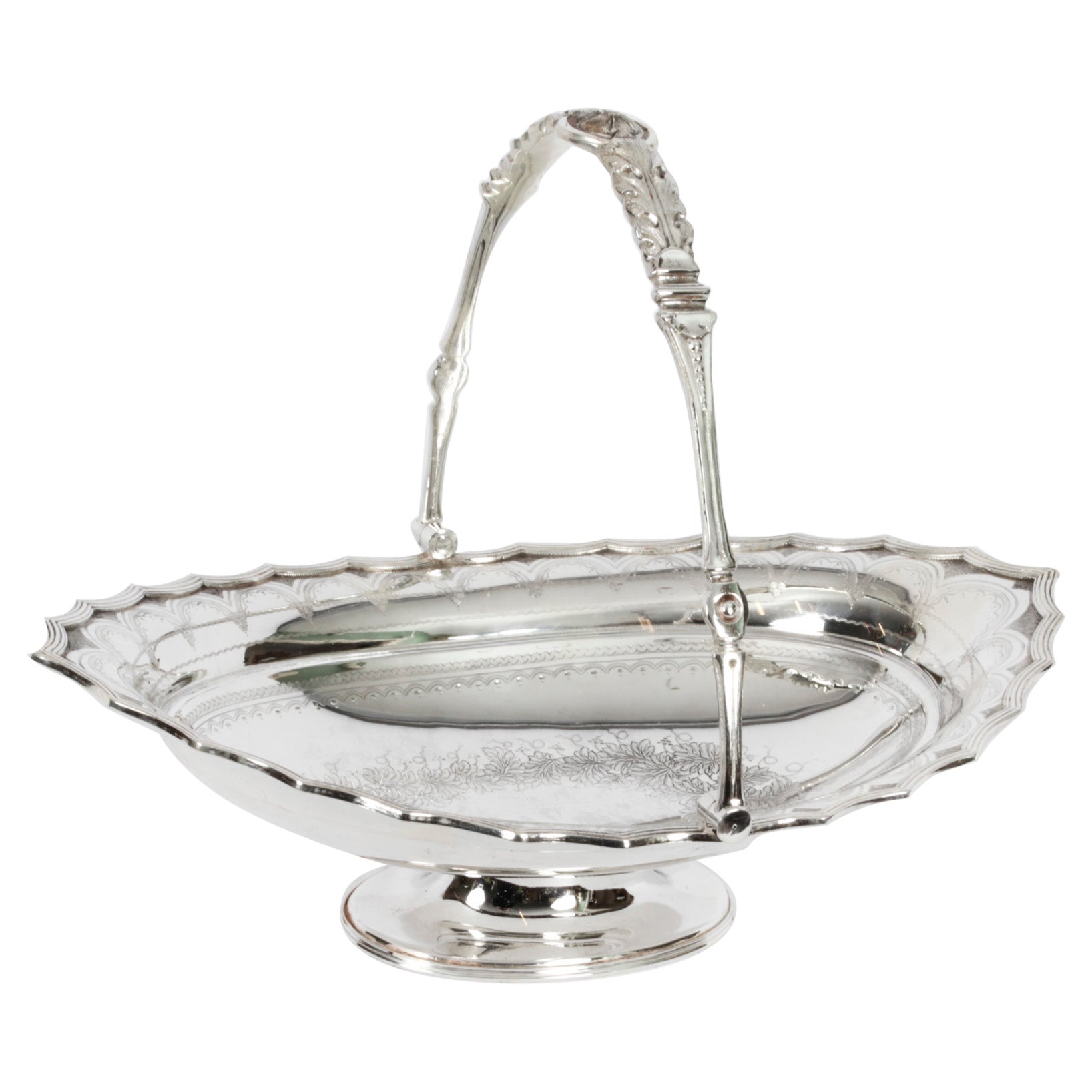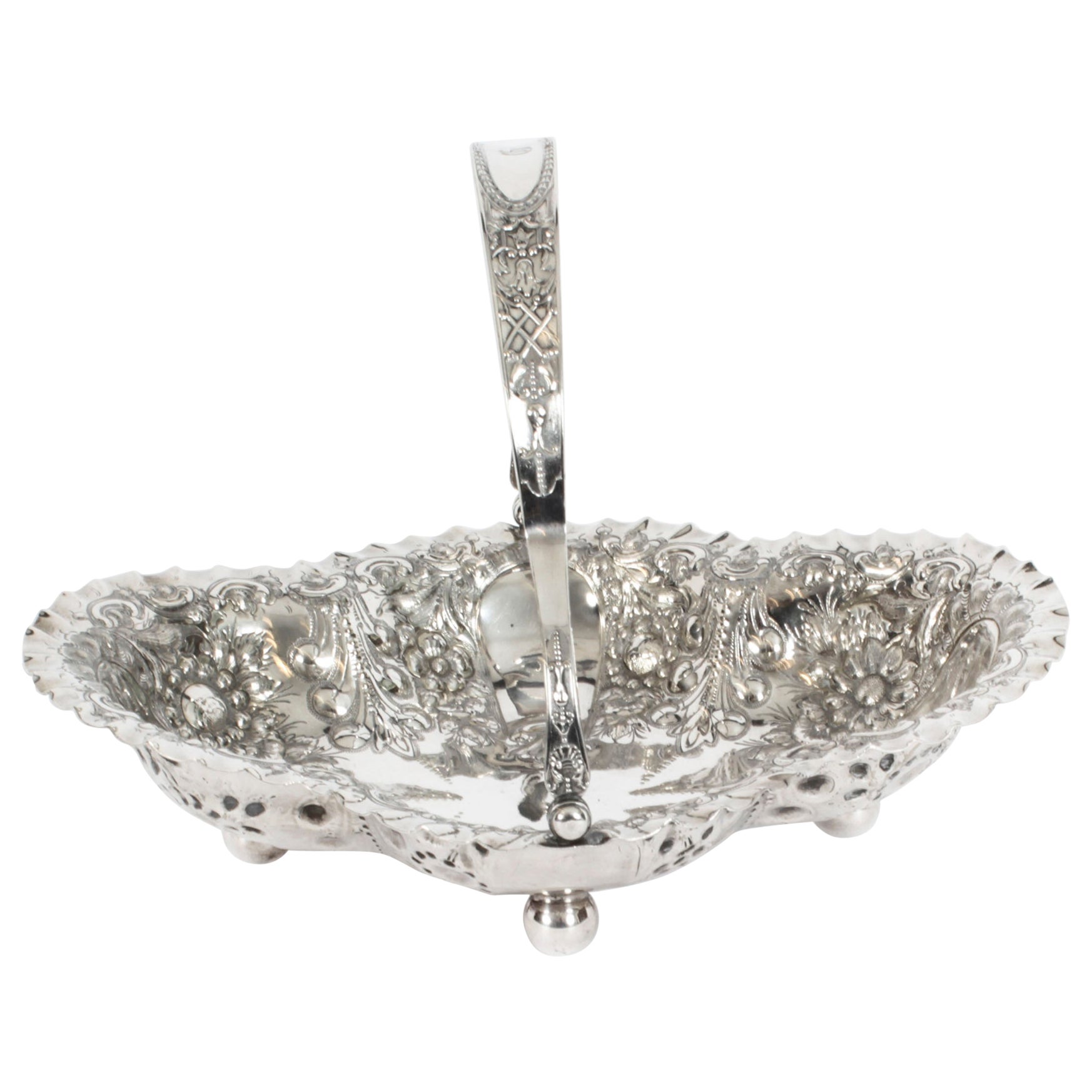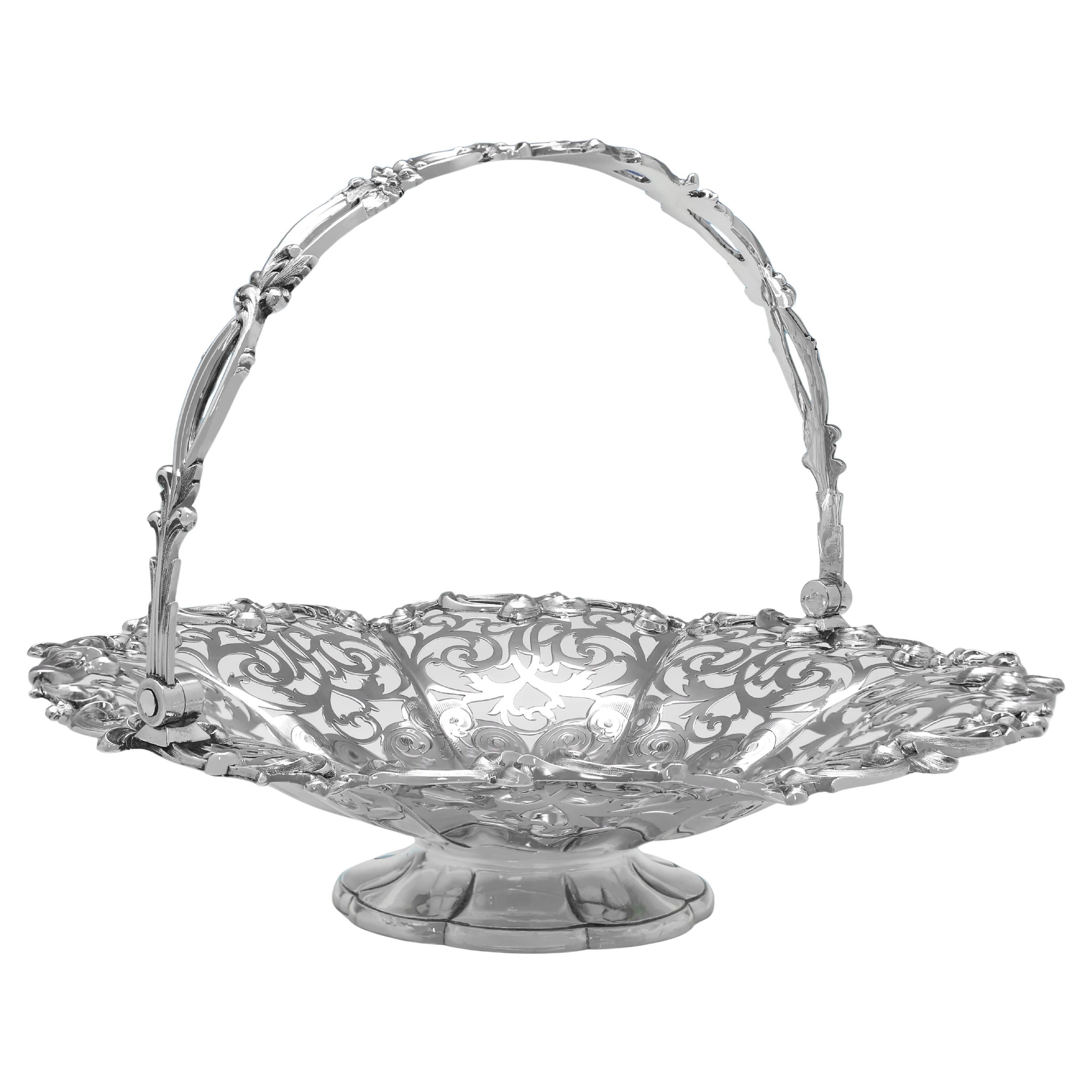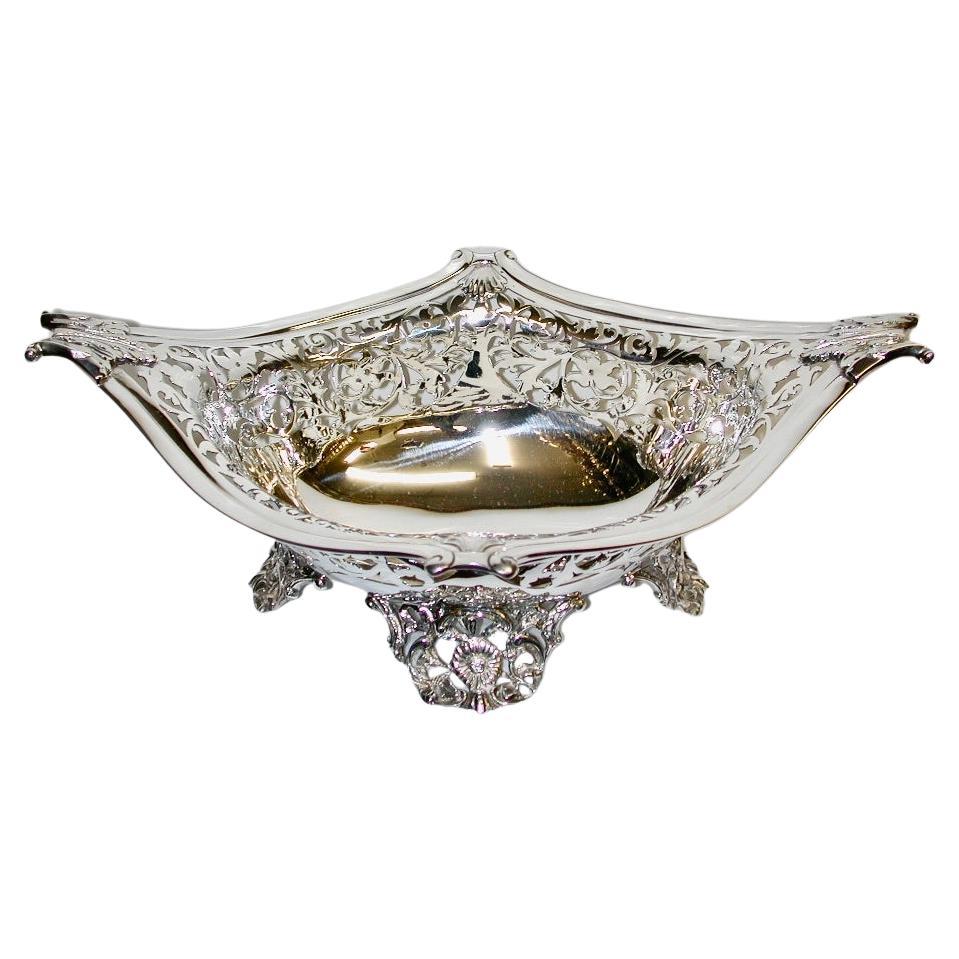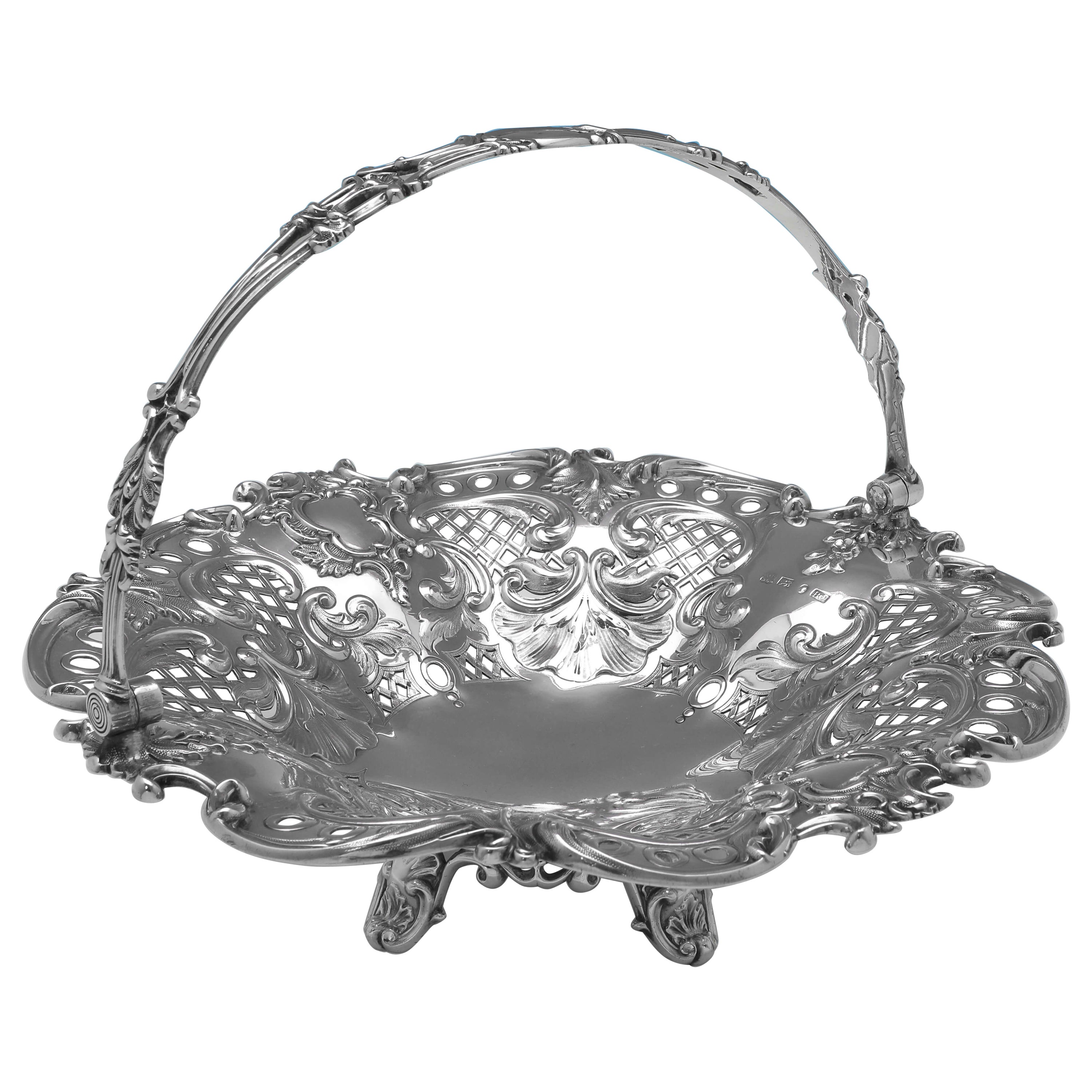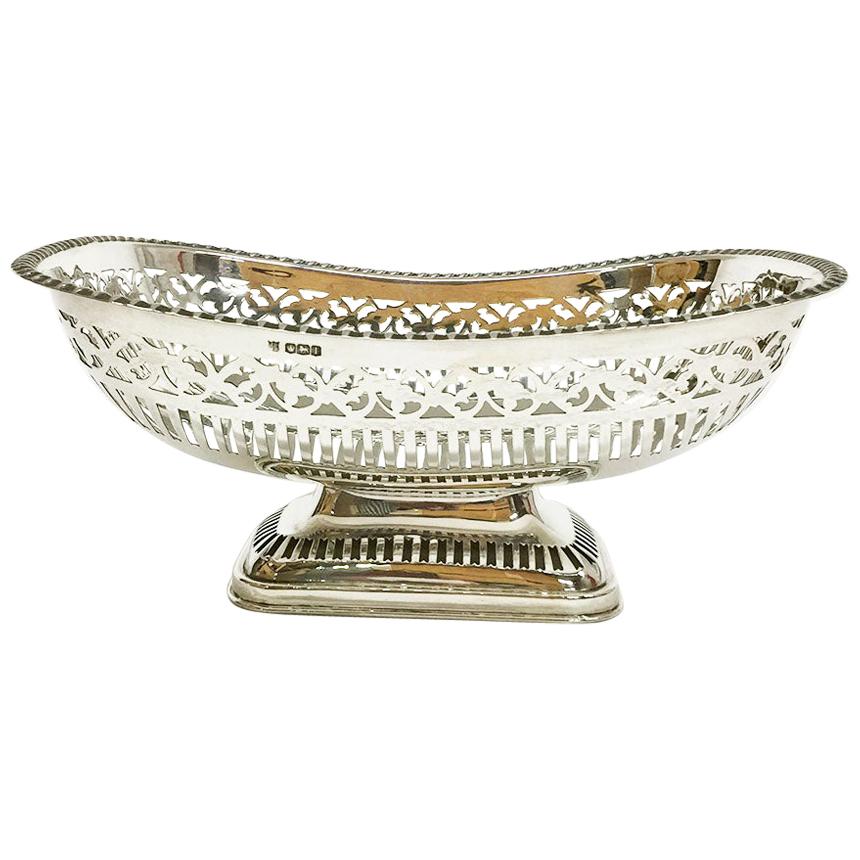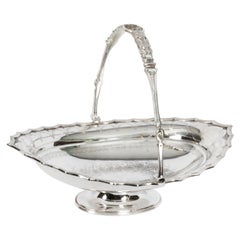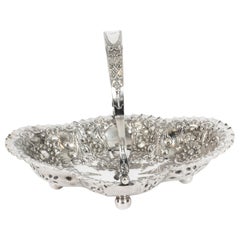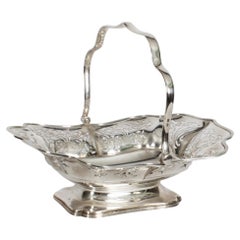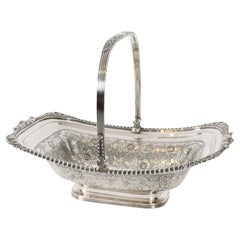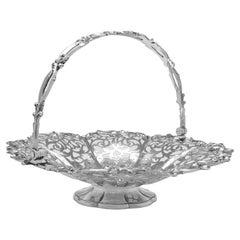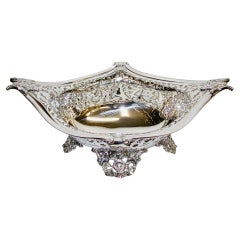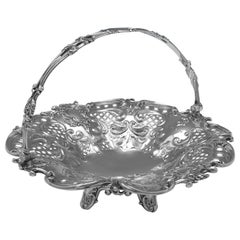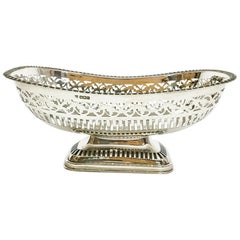Artículos similares a Antique Old Sheffield Plated Fruit Basket by Matthew Boulton 19th Century
Cargando vídeo
¿Quieres más imágenes o vídeos?
Solicita imágenes o vídeos adicionales al vendedor
1 de 16
Antique Old Sheffield Plated Fruit Basket by Matthew Boulton 19th Century
449,02 €
Envío
Recuperando presupuesto…La promesa de 1stDibs
Garantía de autenticidad,
Garantía de devolución de dinero,
Cancelación dentro de las 24 horas
Acerca del artículo
This is a stunning George III Old Sheffield Plate swing handled cake/fruit basket bearing the sunburst makers marks of the world renowned silversmith Matthew Boulton, circa 1820 in date.
The basket features a swing handle, is chased and engraved with flowers, scrolling stiff leaves and fruiting vine and has a wonderful engraved coat of arms in the centre.
The attention to detail is absolutely fantastic and it is certain to attract attention wherever it is placed.
Condition:
In excellent condition with clear makers marks and no dings, dents or signs of repair. Please see photos for confirmation.
Dimensions in cm:
Height 24 cm x Width 30 cm x Depth 30 cm
Dimensions in inches:
Height 9 inches x Width 1 foot x Depth 1 foot
Matthew Boulton
Boulton was not a "goldsmith" or a "silversmith" in the accepted sense, yet for his achievements and services to the craft of goldsmithing he is fully worthy of inclusion in the list of great English goldsmiths.
Matthew Boulton was born in Birmingham on 3 September 1728. His father Matthew Boulton (senior) was a "toy maker" and silver stamper specialized in the production of shoe-buckles.
Boulton junior was taken into partnership in 1749 and was left in sole charge of the business after the death of his father in 1759.
Boulton had the ambition to establish a manufacturing complex where craftsmen in the various branches of the "toy" trade would work together under one roof, enabling him to reap both wholesale and retail profits. In 1761 he realized his project purchasing a one-hundred- year-lease of the "Soho" estate at Handswoth Heath (two miles from Snow Hilton the Wolverhampton Road).
In 1762 Boulton took into unofficial partnership John Fothergill who would act as a travelling salesman to advertise his wares and the factory moved to Soho in the same year.
The partnership concentrated in the production of steel "toys" a little later on buttons and buckles made in a variety of substances, including , of course, silver. In 1762 Soho factory began to produce articles in "Sheffield" plate and one of the first to adopt "Sterling silver thread" edging which prevent to reveal the underlying copper.
Boulton soon became the largest manufacturer of "Sheffield plate" of the country expanding the business of Soho manufactory in the production of bijouterie, objects d'art and de virtue, in ormolu, pinchbeck and shell, and in clocks.
In 1765 Boulton began the manufacture of pieces in solid silver, being obliged to send every piece of plate to Chester to be marked (Chester was the nearest assay office, 72 miles away from Birmingham). Boulton was the promoter a petition obtaining in 1773 the Royal Assent to assay silver in Birmingham (the same was for Sheffield).
Boulton & Fothergill entered their joint mark consisting of their initials, MB before IF. After the death of Fothergill (1782) Boulton punched his plate with his initials alone.
When manufacturers of plated ware were permitted to register their marks at the Assay Office in Sheffield (1784), Boulton registered his mark of "twin suns" under the name Boulton M. & Co.
The most important designers for Boulton plate in the neo-classic taste were Robert Adams and James Wyatt.
Matthew Boulton died on 17 August 1809.
The mark MB continued to be used by Matthew Boulton Plate Co until 1832.
Old Sheffield Plate - or ‘fused plate’ as it is sometimes known, was the first commercially viable method of plating metal.
The material was accidentally invented by Thomas Boulsover, of Sheffield's Cutlers Company, in 1743. While trying to repair the handle of a customer's decorative knife, he heated it too much and the silver started to melt. When he examined the damaged handle, he noticed that the silver and copper had fused together very strongly. Experiments showed that the two metals behaved as one when he tried to reshape them, even though he could clearly see two different layers.
Boulsover set up in business, funded by Strelley Pegge of Beauchief, and carried out further experiments in which he put a thin sheet of silver on a thick ingot of copper and heated the two together to fuse them. When the composite block was hammered or rolled to make it thinner, the two metals were reduced in thickness at similar rates. Using this method, Boulsover was able to make sheets of metal which had a thin layer of silver on the top surface and a thick layer of copper underneath. When this new material was used to make buttons, they looked and behaved like silver buttons but were a fraction of the cost.
The technique Boulsover developed was to sandwich an ingot of copper between two plates of silver, tightly bind it with wire, heat it in a furnace and then mill it out in to sheet, from which objects could be made.
Our reference: A4520
- Dimensiones:Altura: 24 cm (9,45 in)Anchura: 30 cm (11,82 in)Profundidad: 30 cm (11,82 in)
- Estilo:Jorge III (En el estilo de)
- Materiales y técnicas:
- Lugar de origen:
- Época:
- Fecha de fabricación:circa 1820
- Estado:
- Ubicación del vendedor:London, GB
- Número de referencia:Vendedor: A45201stDibs: LU950645390982
Sobre el vendedor
5,0
Vendedor Platino
Vendedores premium con una calificación de +4,7 y tiempos de respuesta de 24 horas
Establecido en 1983
Vendedor de 1stDibs desde 2012
1374 ventas en 1stDibs
Tiempo de respuesta usual: <1 hora
Asociaciones
LAPADA - The Association of Arts & Antiques Dealers
- EnvíoRecuperando presupuesto…Envío desde: London, Reino Unido
- Política de devolución
Partes de esta página se han traducido automáticamente. 1stDibs no puede garantizar la exactitud de las traducciones. El inglés es el idioma predeterminado de este sitio web.
Garantía de autenticidad
En el improbable caso de que haya algún problema con la autenticidad de un artículo, ponte en contacto con nosotros en un plazo de 1 año para recibir un reembolso total. DetallesGarantía de devolución de dinero
Si tu artículo no es como se describe, sufre daños durante el transporte o no llega, ponte en contacto con nosotros en un plazo de 7 días para recibir un reembolso total. DetallesCancelación dentro de las 24 horas
Tienes un período de gracia de 24 horas para reconsiderar tu compra, sin preguntas.Vendedores profesionales aprobados
Nuestros vendedores de primera clase deben cumplir estrictos estándares de servicio para mantener la integridad de nuestros anuncios.Garantía de igualación de precios
Si encuentras que un vendedor publicó el mismo artículo por un precio menor en otro lado, igualaremos ese precio.Entrega global de confianza
Nuestra red de transporte de primera ofrece opciones de envío especializado en todo el mundo, que incluye envío personalizado.Más de este vendedor
Ver todoAntigua cesta de fruta victoriana bañada en plata Siglo XIX
Se trata de una impresionante cesta de fruta victoriana antigua bañada en plata, fechada hacia 1860.
El cuerpo de forma ovalada presenta una fabulosa decoración foliada grabada.....
Categoría
Antiguo, Década de 1860, Inglés, Victoriano, Vajilla de plata y Sheffield
Materiales
Chapado en plata
Antigua cesta de fruta victoriana bañada en plata James Dixon Siglo XIX
Por James Dixon & Sons
Se trata de una cesta de fruta inglesa victoriana bañada en plata, excepcionalmente fina, con los sellos del célebre platero James Dixon, fechada hacia 1880.
Este magnífico cesto...
Categoría
Antiguo, Década de 1880, Inglés, Victoriano, Vajilla de plata y Sheffield
Materiales
Chapado en plata
Antiguo Eduardo VII inglés Cesta de pan de frutas en plata de ley Sheffield, 1907
Por Atkin Brothers
Se trata de una cesta de fruta de plata de ley inglesa de la época eduardiana, excepcionalmente fina, con los sellos de Sheffield 1907 y la marca del fabricante Atkin Brothers.
Es...
Categoría
Antiguo, Principios del 1900, Inglés, Eduardiano, Vajilla de plata y She...
Materiales
Chapado en plata
Antiguo cesto de plata sobre cobre Jorge III de Sheffield Siglo XIX
Se trata de una fabulosa cesta de pan/frutero antiguo neoclásico Jorge III de Sheffield, de plata sobre cobre, fechado hacia 1810.
La cesta rectagular de asa oscilante presenta un c...
Categoría
Antiguo, siglo XIX, Inglés, Neoclásico, Vajilla
Materiales
Chapado en plata, Cobre
Antiguo cesto de plata sobre cobre de Jorge III de Sheffield, Siglo XVIII
Se trata de una fabulosa cesta de pan/frutero antiguo neoclásico Jorge III de Sheffield, de plata sobre cobre, fechado hacia 1780.
El plato oval de asa oscilante presenta un cuer...
Categoría
Antiguo, Década de 1780, Inglés, Jorge III, Vajilla de plata y Sheffield
Materiales
Placa de Sheffield
Sopera de Plato Antiguo de Sheffield y Tapa Abovedada, Siglo XVIII
Se trata de una magnífica sopera inglesa antigua de plata de Sheffield con la tapa abovedada original, fechada hacia 1790.
Lleva la marca en forma de cruz de I.E de John Edwards III...
Categoría
Antiguo, Década de 1790, Inglés, Vajilla de plata y Sheffield
Materiales
Placa de Sheffield
También te puede gustar
Cesta de fruta de plata de ley del siglo XIX fabricada en Londres en 1853
Por James & Nathaniel Creswick
Marcada en Londres en 1853 por James & Nathaniel Creswick, esta atractiva cesta victoriana de plata de ley antigua presenta un borde fundido, decoración perforada y grabada en el cue...
Categoría
Antiguo, Década de 1850, Inglés, Victoriano, Cestas decorativas
Materiales
Plata esterlina
Antigua cesta de fruta victoriana de plata fechada en 1898 Londres William Hutton & Sons
Por William Hutton & Sons
Antigua cesta de fruta victoriana de plata fechada en 1898 Londres William Hutton & Sons Ltd
Fabulosa cesta que se puede utilizar para muchas cosas además de fruta, por ejemplo, pan,...
Categoría
Antiguo, Década de 1890, Inglés, Victoriano, Plata esterlina
Materiales
Plata esterlina
Cesta victoriana antigua de plata de ley - Sheffield 1845 - Hawksworth Eyres
Marcada en Sheffield en 1845 por Hawksworth Eyres & Co., esta atractiva cesta de plata de ley antigua tiene un diseño ornamentado, se apoya en pies de concha fundida y presenta decor...
Categoría
Antiguo, Década de 1840, Inglés, Victoriano, Plata esterlina
Materiales
Plata esterlina
Cesta de fruta inglesa de plata de ley de James Deakin & Sons, 1928
Por James Deakin & Sons
Cesta de fruta inglesa de plata de ley de James Deakin & Sons, 1928
Una cesta inglesa rectangular de plata para fruta elevado sobre una base.
Cesta de plata de ley de Sheffield con...
Categoría
principios del siglo XX, Británico, Plata esterlina
Materiales
Silver
L & WS Cesta Victoriana Inglesa de Frutas con Pie y Asa, Plateada
Antigua cesta de fruta con pie y asa L & WS inglesa victoriana chapada en plata. Mediados del siglo XX.
Medidas: 3,5" de alto x 12" de ancho x 9,5" de profundidad.
Categoría
mediados del siglo XX, Victoriano, Cuencos decorativos
Materiales
Chapado en plata
Cesta de plata inglesa victoriana de finales del siglo XIX para pasteles Melvin Pratt con asa
Cesta redonda de plata Melvin Pratt de finales del siglo XIX, de época victoriana inglesa, con diseño calado y motivos de follaje. Creada en Inglaterra por Melvin Pratt durante los ú...
Categoría
Antiguo, siglo XIX, Inglés, Victoriano, Vajilla de plata y Sheffield
Materiales
Silver
